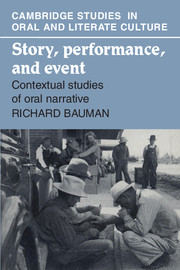5 - “I go into more detail now, to be sure”
Narrative variation and the shifting contexts of traditional storytelling
Published online by Cambridge University Press: 05 June 2012
Summary
Introduction
Perhaps the most basic and persistent problem confronted by students of oral literature is gauging the effect of the interplay of tradition and innovation, persistence and change, as manifested in the oral text. I have already touched on this problem in my analysis of reported speech in a series of West Texas oral anecdotes (Chapter 4), which revealed that those narratives in which quoted speech served as a kind of punch line were markedly more stable over time than those in which an instance of quoted speech was not the point of the story. For much of the history of modern folklore scholarship, the scales in which folklorists have weighed this dynamic interplay between tradition and innovation have been overbalanced rather strongly in favor of traditionality and persistence. Tradition has been the privileged term, consistent with the larger frames of reference predominant in social thought that have held the folk – peasants and primitives – to be conservative, “tradition bound,” resistant to change, and so on (Bauman 1977c, 1982; BenAmos 1972).
The past couple of decades, however, have witnessed an accelerating shift in perspectives on the dynamics of folklore that have begun to redress the imbalance. The recent burgeoning of a performance-centered perspective, especially, has brought with it a growing awareness of the role of individual creativity in oral literature and of texts as situated and emergent within particular contexts (Bauman 1977b; Ben-Amos and Goldstein 1975; Paredes and Bauman 1972).
- Type
- Chapter
- Information
- Story, Performance, and EventContextual Studies of Oral Narrative, pp. 78 - 111Publisher: Cambridge University PressPrint publication year: 1986
- 3
- Cited by



